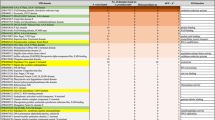Abstract
The 3′ regions of the gene encoding the cap binding protein eIF4E were successfully isolated from Agaricus bisporus and Verticillium fungicola using a degenerate primer within the eIF4E gene and an anchored oligo d(T) primer. The deduced amino acid sequences contained 173 residues for A. bisporus and 171 residues V. fungicola. Analysis of these sequences shows that despite conserved regions of homology, centering around tryptophan residues, A. bisporus and V. fungicola are very diverse at the amino acid and DNA level. Percentage homology between the two fungi is low at the nucleotide, 35%, and amino acid level, 29%. The highest degree of similarity between the A. bisporus sequence and other published sequences is with the Homo sapiens eIF4E sequence (32%). V. fungicola exhibited highest homology with the eIF4E sequence from Caenorhabditis elegans (34%). Southern analysis of genomic DNA indicated a single copy of the gene within the A. bisporus genome.
Similar content being viewed by others
References
Elliott T. Mushrooms. SGM Quarterly 1997; February 8-9.
North LH, Wuest PJ. The infection process and symptom expression of Verticillium disease of Agaricus bisporus. Canadian Journal of Plant Pathology 1993; 118(2): 551–555.
Dragt JW, Geels FP, de Bruijin WC, van Griensven LJLD. Intracellular infection of the cultivated in mushroom Agaricus bisporus by the mycoparisite Verticillium fungicola var. fungicola. Mycological Research 1996; 100(9): 1082–1086.
Ware WM. A disease of cultivated mushrooms caused by Verticillium malhousei sp. nov. Annals of Botany 1933; 47: 763–785.
Jeffries P, Young TWK. Interfungal Parasitic Relationships. CAB International/Wallimgford U.K. 1994; 8, 172–175.
Browning KS. The plant translational apparatus. Plant Molecular Biology 1996; 32: 107–144.
GaIlie DR. Translational control of cellular and viral mRNAs. Plant Molecular Biology 1996; 32: 145–158.
Rodriguez CM, Freire MA, Camilleri C, Robaglia C. The Arabidopsis thaliana cDNA's encoding for eIF4E and elF(iso)4E are not functionally equivalent for yeast complementation and are differentially expressed during plant development. Plant Journal 1998; 13 (4): 465–473.
Sonenberg N, Gingras A-C. The mRNA 5_cap binding protein eIF4E and control of cell growth. Current Opinion in Cell Biology 1998; 10: 268–275.
McKendrick L, Pain VM, Morley SJ. Translation initiation factor 4E. The International Journal of Biochemistry and Cell Biology 1999; 31: 31–35.
Sambrookj, Fritsch E, Maniatis T. Molecular Cloning: A laboratory manual. Cold Spring Harbor Laboratory Press, 1989.
Yoon CS, Glawe DA, Shaw PD. A method for rapid small scale preparation of fungal DNA. Mycologia 1991; 83(6): 835–838.
Author information
Authors and Affiliations
Rights and permissions
About this article
Cite this article
Athey-Pollard, A., Kirby, M., Potter, S. et al. Comparison of partial sequence of the cap binding protein (eIF4E) isolated from Agaricus bisporus and its pathogen Verticillium fungicola . Mycopathologia 156, 19–23 (2003). https://doi.org/10.1023/A:1021318524857
Issue Date:
DOI: https://doi.org/10.1023/A:1021318524857




